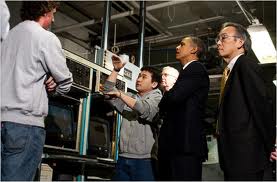Green Real Estate Investment Trusts – Green REITs
REITs to Green Buildings: Leading the way toward a Stronger Commercial Real Estate Market?
By: Luke Bujarski
 Active property investors might want to pay close attention to a renewed interest in “green” real estate investment trusts, also known as REITs. With the recently announced Better Buildings Initiative, President Obama has pledged new tax incentives and financial products to encourage these asset portfolio companies to retrofit the existing stock of commercial properties. If these national and local policy efforts begin to work as intended, REITs should be among the first to react. Those REITs taking advantage of new government tax breaks and funds might seize the opportunity to rebrand themselves as best-in-class, high-performance real estate asset portfolios.
Active property investors might want to pay close attention to a renewed interest in “green” real estate investment trusts, also known as REITs. With the recently announced Better Buildings Initiative, President Obama has pledged new tax incentives and financial products to encourage these asset portfolio companies to retrofit the existing stock of commercial properties. If these national and local policy efforts begin to work as intended, REITs should be among the first to react. Those REITs taking advantage of new government tax breaks and funds might seize the opportunity to rebrand themselves as best-in-class, high-performance real estate asset portfolios.
Obama’s Better Buildings Initiative has challenged America’s commercial building sector to become 20 percent more energy efficient over the next decade. Among the various measures proposed include:
» Converting the current commercial building tax deduction into a more attractive tax credit
» Working with existing lenders to promote new energy efficiency retrofit loans for small businesses
» Providing additional financing opportunities in the form of loan guarantees for energy efficiency upgrades
» Encouraging local governments to streamline standards and encourage private sector investment
REITs have traditionally stayed away from large-scale retrofits for three reasons: First, because the pay-back from energy savings is usually measured over 20 or 30 years, which is much longer than a typical investor’s holding period. Second, since tenants often need to be vacated during the conversion, retrofitting can seriously disrupt revenue flows. Third, tenant lease restrictions limit the owner’s ability to relocate tenants during renovation. Furthermore, these barriers come on top of the added commitment of raising money for the actual retrofit.
Despite these obstacles, an energy efficient property is still more attractive to both renters and investors. For this reason, talks of “green” trusts were gaining momentum up through the early parts of 2008, prior to the August sub-prime mortgage collapse. However, these green-driven REITs were banking on the influx of newly constructed, energy efficient properties to attract investors.
Since the crisis put a dead stop to the majority of new construction proposals, the broader energy and economic policy focus has shifted to existing building retrofits. Consequently, government has steadily drummed up support for market-based solutions to stimulate the retrofit market.
If the measures proposed within the Better Buildings Initiative pass into law, REIT fund managers will likely react with a renewed interest in promoting green-driven, high-performance portfolios. Company branding and marketing strategies will inevitably follow suit in the form of press releases, energy performance portfolio listings, new web content, tweets and other creative means to reign in fresh capital.
Ultimately, the question is whether Obama’s proposed measures will be enough to nudge REITs to take on the up-front costs of large-scale retrofits.
Related posts:








Leave your response!
You must be logged in to post a comment.